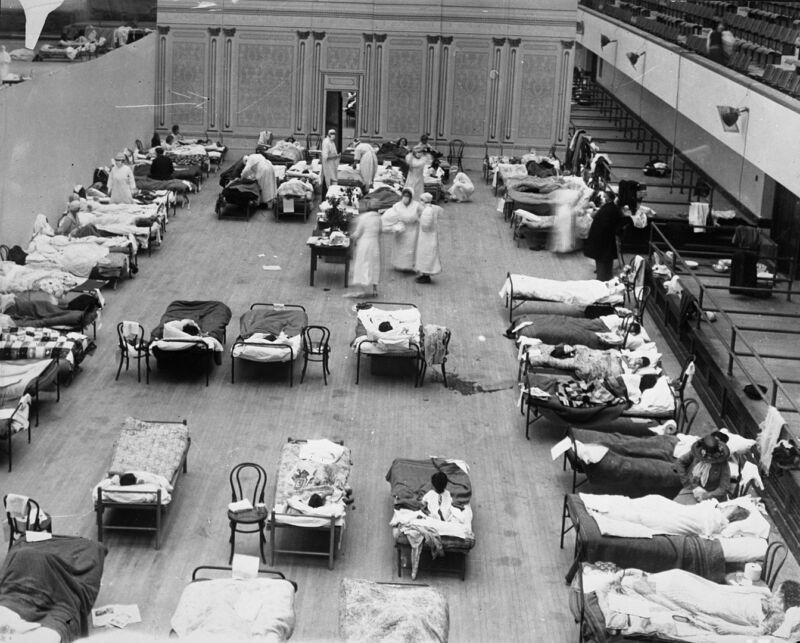Cities that locked down faster in 1918 bounced back better.

The lockdown measures being taken in response to the coronavirus pandemic are causing economic turmoil. Faced with this, President Donald Trump balked at the prospect of continuing those measures long-term, tweeting, “WE CANNOT LET THE CURE BE WORSE THAN THE PROBLEM ITSELF.”
But in reality, the best economic medicine may be the dreaded lockdown. A working paper by economists at the Federal Reserve and MIT digs into data from the 1918 flu pandemic and finds that cities that reacted quickly and aggressively to the pandemic also had stronger economic growth after the crisis was over.
Looking backward
An armchair economist could happily predict the economic effects of a lockdown. Intuitively, freezing the economy of a city, state, or country by forcing everyone to stay home seems like it would be an unambiguously bad thing for that economy.
But “economic activity is also reduced in absence of such measures,” write economists Sergio Correia, Stephan Luck, and Emil Verner. Even without lockdown orders, people living through a pandemic have a tendency to stay home as much as possible and change their economic habits to minimize their chances of getting infected. So if a lockdown helps to bring an outbreak to heel more effectively, it could actually help to reduce economic damage.
The 1918 flu pandemic offers a potential insight into how city and state economies responded to different public health strategies. Peaking in the US in fall 1918, the pandemic is estimated to have killed around 600,000 people in the US and 50 million worldwide.
Just like in the current pandemic, there was a pretty wide range of responses to the outbreak. Some cities reacted promptly, implementing measures similar to those we’re seeing now—banning of mass gatherings, social distancing, and case isolation. Others were tardier. Correia and colleagues pulled together a range of sources of historical data to take a look at how different cities responded and how their economies fared afterward.
Causal spaghetti
The only thing that’s really possible to do with this kind of historical data is look at correlations: whether cities that responded faster had, on average, better economic growth post-pandemic. The problem with correlations is that they can’t show for sure whether the fast response boosted the economic growth or whether there’s some other relationship between the two factors—like economically healthier cities having better public health infrastructure in the first place, or some third factor underlying both the response and the economic growth.
But by trying to think about what other explanations there could be and controlling for them in the analysis, it’s possible to tease out which factors offer the most reasonable explanation for the data. That’s what Correia and colleagues did. Places that responded faster in 1918 tended to be farther west, giving them a chance to witness what had happened as the pandemic hit first on the East Coast. But this also meant that places that shut down sooner had economies that were relatively agriculture-based.
This means that there were two simultaneous differences between groups of cities, making it difficult to tell which difference was more important—are any differences best explained by the western cities responding faster to the pandemic? Or did their more agriculture-based economies respond differently for other reasons?
To deal with this, the researchers made sure that their analysis accounted for the relative importance of agriculture compared to manufacturing in local economies. They also checked whether there were other systematic differences that they needed to control, like whether western regions had stronger average health infrastructure than eastern regions. And they accounted for the flu mortality that different places had seen before 1917, which helped to make sure that any differences were down to responses to the 1918 pandemic specifically and not just different regions’ exposure to imported infectious diseases generally.
More lockdowns, better growth
Cities that responded faster and more aggressively to the pandemic had better growth in employment and manufacturing output compared to cities with weaker responses. On average, cities that responded eight days earlier had four percent higher employment after the pandemic compared to cities that responded later. And cities that kept their measures in place for an extra six weeks or so had, on average, six percent higher employment afterward.
There are some important uncertainties in this analysis. For one thing, there was a huge range of outcomes in the cities that Correia and colleagues studied. The speed and aggression of each city’s pandemic response can explain some of the difference in those outcomes, but there’s a lot more to understand. Seattle, for instance, responded about as quickly as Cincinnati but had much better growth afterward. That doesn’t change anything about the finding of the correlation, but it does mean that there’s much more to the story to uncover in future research. It will be important to figure out what else played a role in economic resilience.
And, of course, the 1918 pandemic is not a perfect proxy for what’s happening right now. It came at the end of a world war and killed huge numbers of working-age people. The different nature of the modern economy, with its communications technology, global supply chains, and dependence on services other than manufacturing, makes it difficult to understand how these responses will translate a century later.
But as with a lot of coronavirus research, uncertainty is unavoidable. The past can still be a useful guide, if not an exact template. And that past shows clearly that lockdowns don’t inevitably lead to worse economic outcomes—and that there’s a strong chance they’re the best option for both lives and the economy.
Contact Information:
CATHLEEN O'GRADY
Tags:
, Wire, United States, English
Contact Information:
CATHLEEN O’GRADY

